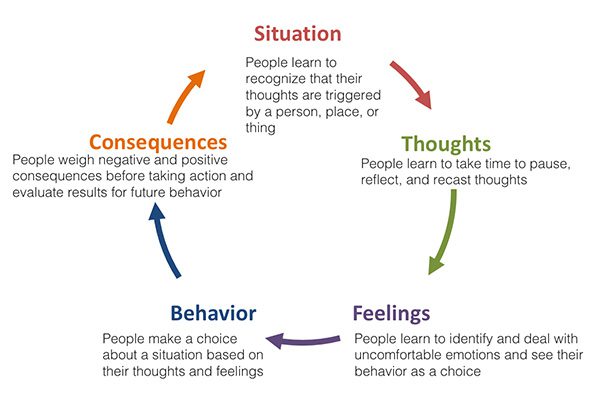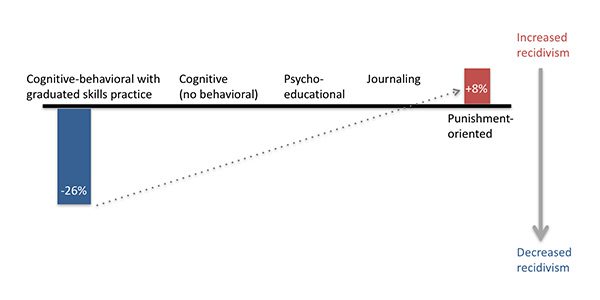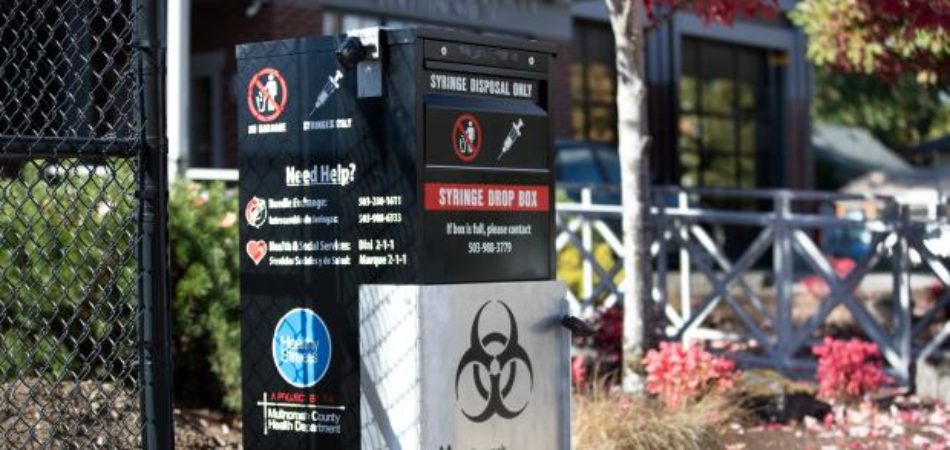In Brief: Using a Cognitive-Behavioral Approach in Programs to Reduce Recidivism
Cognitive-behavioral interventions (CBI) help people to recognize situations that trigger unwanted behavior and to cope with the thoughts and feelings that contribute to this behavior. This approach is used to help people manage depression, anxiety, substance use, and other health problems. The principles of CBI have been successfully adapted for use with people involved in the criminal justice system, specifically to help them understand and change their criminal thinking patterns.
Figure 1. How a Cognitive-behavioral Approach Works to Change Behavior1

Programs for the criminal justice population that take a cognitive-behavioral approach can help people improve their critical and moral reasoning, social skills, self-control, problem solving, and impulse control and are most effective when they include structured social learning components where new skills, behaviors, and attitudes are consistently reinforced. Role-playing, cognitive skills training, anger management, moral development, and relapse prevention are common elements of these programs.2
Through structured exercises, a person learns to replace problematic thoughts with constructive ones. The instructor facilitates learning by modeling prosocial thoughts and demonstrating prosocial behaviors before participants practice the steps involved in a new behavior through role-play. For example, a program could help a person struggling with substance use recognize the thoughts and feelings triggered by a friend’s invitation to use drugs. Through role-playing, the person practices declining the invitation.
How Do Cognitive-behavioral Programs Help to Reduce Recidivism?
Research has shown that programs using a cognitive-behavioral approach that includes skills practice have the greatest impact on reducing future criminal behavior, with the potential to reduce adult and juvenile recidivism by as much as 26 percent.3 A meta-analysis comparing programs used with the juvenile population found that other types of programs, including those that employ a cognitive approach without addressing behavior, psycho-educational programs that impart information to participants without teaching replacement behaviors, and journaling are less effective. Approaches that focus on punishment are likely to increase recidivism.4 [See Figure 2]
Because cognitive-behavioral programs are also among the most cost-effective that a corrections agency can use, they are becoming a popular recidivism-reduction tool.5 To be most effective at reducing recidivism, cognitive-behavioral programs should target people who are most likely to reoffend and focus on the criminogenic needs most associated with recidivism, including antisocial attitudes, personality, and associates. These programs can be delivered in institutional or community settings by mental health specialists or trained paraprofessionals and can be administered as part of a multifaceted program or as a stand-alone intervention.
Figure 2. Cognitive-behavioral Program Impact on Recidivism Over the Course of Treatment6

- Graphic based on material from Mark Lipsey, Nana Landenberger, Sandra Wilson, “Effects of a Cognitive-Behavioral Program for Criminal Offenders,” (Oslo: The Campbell Collaboration, 2007).
- Ibid.
- Ibid.
- Ibid; Mark Lipsey, “The Primary Factors that Characterize Effective Interventions with Juvenile Offenders: A Meta-Analytic Overview” Victims & Offenders: An International Journal of Evidence-Based Research, Policy, and Practice, 4, no. 2 (2009), 124–147. Other evaluations of similar programs servicing adults found analogous trends as the meta-analysis demonstrates.
- Elizabeth Drake, Inventory of Evidence-Based and Research-Based Programs for Adult Corrections, Document Number 13-12-1901, (Olympia: Washington State Institute for Public Policy, 2013).
- Mark Lipsey, “The Primary Factors that Characterize Effective Interventions with Juvenile Offenders: A Meta-Analytic Overview”.
Additional Resources
- Harvey Milkman and Kenneth Wanberg, Cognitive Behavioral Treatment: A Review and Discussion for Corrections Professionals (Washington, DC: National Institute of Corrections, 2007).
- Patrick Clark, “Preventing Future Crime with Cognitive Behavioral Therapy,” NIJ Journal 265, NCJ 229888 (Washington, DC: NIJ, 2010).
Disclaimer: This project was supported by Grant No. 2015-ZB-BX-K001 awarded by the Bureau of Justice Assistance. The Bureau of Justice Assistance is a component of the Department of Justice’s Office of Justice Programs, which also includes the Bureau of Justice Statistics, the National Institute of Justice, the Office of Juvenile Justice and Delinquency Prevention, the Office for Victims of Crime, and the SMART Office. Points of view or opinions in this document are those of the author and do not necessarily represent the official position or policies of the U.S. Department of Justice.
Arkansas policymakers have long expressed concerns about the state’s high recidivism rate. Over the past 10 years, an…
Read MoreIn April 2025, Arkansas Governor Sarah Huckabee Sanders signed a package of bipartisan criminal justice legislation into law,…
Read More Explainer: Key Findings and Options from Arkansas’s Justice Reinvestment Initiative
Explainer: Key Findings and Options from Arkansas’s Justice Reinvestment Initiative
Arkansas policymakers have long expressed concerns about the state’s high recidivism rate. Over the past 10 years, an estimated 72 percent of prison admissions in the state involved people who were revoked from supervision, with unmet substance use and mental health challenges playing a significant role in these failures.
Read More Explainer: How a New Law in Arkansas Tackles Crime, Recidivism, and Community Supervision Challenges
Explainer: How a New Law in Arkansas Tackles Crime, Recidivism, and Community Supervision Challenges
In April 2025, Arkansas Governor Sarah Huckabee Sanders signed a package of bipartisan criminal justice legislation into law, which is designed to increase public safety and improve community supervision. The legislation passed nearly unanimously.
Read More









